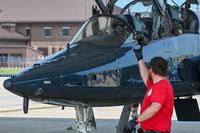The U.S. Defense Department official in charge of the F-35 fighter jet program said a previous flight test maneuver played a role in an engine fire that led to a temporary grounding of the fleet and ongoing flying restrictions.
Speaking during a defense conference Wednesday at the National Press Club, Air Force Lt. Gen. Christopher Bogdan said three weeks before an F-35A made by Lockheed Martin Corp. caught fire during takeoff June 23 at Eglin Air Force Base, Florida, it was flown in a manner designed to test the performance of its g-force, roll and yaw characteristics within designed limits known as the flight envelope.
While the maneuver only last two seconds or so, it caused excessive rubbing between the titanium blade in the fan section of the F135 engine made by United Technologies Corp.'s Pratt & Whitney unit and the surrounding material, Bogdan said. The metal reached temperatures of as high as 1,900 degrees Fahrenheit -- compared to the normal level of about 1,000 degrees -- and resulted in micro-cracking, he said.
A few weeks later, during the fateful takeoff, the blade came apart and actually pierced the left aft fuel tank, engulfing the rear of the plane in flames, Bogdan said. "It was the fuel tank that caught fire," he said.
While the pilot escaped from the aircraft unharmed, much of the plane was destroyed. Bogdan declined to say it was a "total loss" because he said the program office plans to reuse parts that are salvageable. But it's safe to assume the incident was a Class A mishap, which is defined as accidents resulting in fatality or total permanent disability, loss of an aircraft or property damage of $2 million or more.
The Joint Strike Fighter is the Pentagon's most expensive weapons acquisition program, estimated to cost a total of $398.6 billion for a total of 2,457 aircraft. That breaks down to a per-plane cost of $162 million, including research and development.
Under the most recent production contract with Lockheed, the department in 2013 agreed to pay $112 million per F-35A, $139 million per F-35B and $130 million per F-35C. Those figures, known as unit recurring flyaway costs, include the airframe, engine, mission systems, profit and concurrency.
The Pentagon in its budget for fiscal 2015, which begins Oct. 1, requested $8.3 billion for 34 of the aircraft, including 26 F-35As, 6 F-35Bs and 2 F-35Cs. The House Appropriations Committee voted to buy an additional four aircraft, for a total of 38, while the Senate panel agreed with the Pentagon's request — a difference that will have to be resolved in conference negotiations. Congress hasn't yet passed a defense spending bill.
Eight countries have committed to help develop the F-35, including the U.K., Italy, the Netherlands, Turkey, Canada, Australia, Denmark and Norway. Also, Israel, Japan and South Korea plan to buy production models of the aircraft.
There are currently about 100 F-35s in the U.S. fleet, Bogdan said. Pratt & Whitney has delivered roughly 150 F135 engines, he said.
Bogdan said Pratt & Whitney officials have vowed to cover the cost of the engine fix, which will probably include redesigning that part of the propulsion system to create more space in the so-called trench area. He declined to specify how much it will cost until the program office completes a root-cause analysis, expected later this month.
A prototype part may be tested as early as mid-October, Bogdan said. Meanwhile, the program office is developing a new engine break-in procedure as a short-term fix to better analyze how it performs under increasing loads, he said. Even so, if the planes don't resume regular flight testing later this month, the program could be delayed by a month or more, he said.
Separately, Bogdan said, Pratt & Whitney has halted further deliveries of the F135 engine amid plans to sue a supplier for providing "suspect" titanium. The Pentagon's Defense Criminal Investigative Service and the Air Force Office of Special Investigations are looking into the matter, he said.
The suspension affected 10 engines that probably would have been delivered by now and four more that are not yet under contract, according to an article by Tony Capaccio of Bloomberg News.
The F-35 missed its highly hyped international debut in the United Kingdom this summer. Four of the F-35B short take-off and vertical landing models were scheduled to appear at multiple events in the U.K., culminating with a flight demonstration at the Farnborough International Air Show outside London in July.









